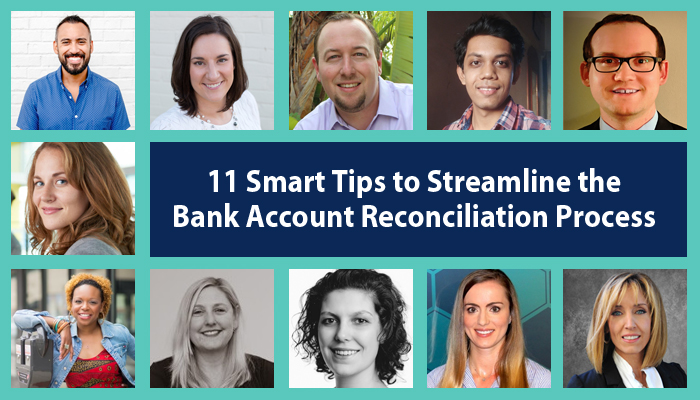
1000+
customers

50+ countries
across the world

Outsourcing leader
since 2008

Technology-driven
services

Stringent
quality processes
Roundup: Smart Tips to Streamline the Bank Account Reconciliation Process by Experts!
Last updated: 27 Nov, 2023 By Alika Cooper | 6 Minutes Read

Bank account reconciliation is a process of comparing bank statements with the cash book which businesses maintain internally. This process is quite crucial, yet a long and tedious one. Many entrepreneurs procrastinate this work for next day, which ultimately adds to the complexity of the entire accounting process. Nothing is impossible, and the bank account reconciliation process can be managed appropriately too.
We have discussed with experts and asked them to share their contribution to this problem. So, below-mentioned are 10 valuable tips that can assist you in simplifying this process:
1. Use cloud-based accounting software

Lozelle Mathai, MBA
Founder of Body of Accounting
With the use of cloud-based accounting software, you get direct access to bank and credit card accounts. This allows you to view transactions daily. Take advantage of such real-time data by reviewing, matching, and categorizing transactions weekly. Waiting until the end of the month can leave you feeling overwhelmed, especially if you have multiple banks and credit card accounts. This overwhelmed feeling can make looking for an error a difficult task.
2. Start from the scratch

Tiffany Powell
Founder of Sapphire Bookkeeping
I own an accounting firm in Glendale, AZ, and complete bookkeeping and bank reconciliations for various clients during the month, along with our own bookkeeping. There are quite a few options for help with importing and sorting bank transactions within the various accounting software.
The largest issue we find when taking over someone’s books is the initial set-up. The other issue we have is of locations where multiple categories of items can be purchased. We always recommend clearing prior rules created for bookkeeping and starting from scratch so that all rules are effective and are efficient for importing transactions correctly.
This can be as simple as making sure to remove store off the transaction name and leaving only the full name of the business that is being purchased from. We also tell clients to never remove or exclude transactions until after the bank reconciliation has been completed, and you can verify whether it is a miss-match or duplicate.
3. Use software that includes bank feeds

Joanne McCauley
Founder of Tradie WAGS
The most effective way to streamline the bank reconciliation process is to use software that includes bank feeds, such as Xero, QB Online, or MYOB. Not only does it save time, but it increases accuracy. You do not need to code the amount but only the account where the transaction needs to be recorded to.
These programs also have the ability to set up “rules” which further eliminates the thought process of where to code the transaction, and of course, it saves time. It is always important to still use the reconciliation function or reconciliation report in each system to ensure that your calculated bank balance equals your actual bank balance. These balances don’t necessarily match even with the bank feeds, so checking the balances on a regular basis will help to identify the errors quickly.
My other tip is to make the bank account reconciliation process a habit and do it regularly. A lot of business owners leave it until the last minute and reconcile once a quarter or once a year. The task then seems to be daunting, and you are less likely to remember what the transaction related to.
Reconciling is simple if you have bank feeds. Set aside a time each day or week to be on top of it. Link it to something, so you don’t forget. For example, when you have a mid morning coffee break, reconcile your bank account, or once a week, go to a cafe, have a nice coffee and get your accounts up to date. If you do it daily, it can literally take minutes.
4. Have a session with a suitably qualified bookkeeper

Korryn Malzard
Founder of virtuallyvirtual
As a BAS agent, the most common habits that I notice in clients are:
– Not having a suitable accounting system for their needs
– Unable activating bank feeds if their accounting system supports it
– Non-checking the bank reconciliation statements against the actual bank statement for any errors
– Attempting to delete transactions or bring in personally paid business ones incorrectly
– Ignoring statement errors, making them more difficult to locate and fix
Often this can take some education to stop but for those wanting to do their reconciliation themselves should at the very least have a session with a suitably qualified bookkeeper for training, in addition to having their input at regular intervals to check and make sure you are on the right track.
It is important for business owners to remember that their accounting software is one of the cornerstones of business, and they should be considering their growth options when opting into a provider.
5. Done by a different person

Tatiana Giberson
CPA at Evergreen Business Solutions
I’m a CPA in Canada, with experience in bank reconciliations for businesses small and large. I’ve been preparing monthly bank reconciliations for a suite of clients on a monthly basis for several years.
According to me, I am sharing a few tips that will help you in a better way:
No. 1 Tip:
Use the bank feed (or statement) to confirm existing transactions. Business transactions should not be created from the bank feed, but entered as the business transactions occur in the normal course of business – sales invoices should be sent out as work is prepared, bills should be entered and paid in the normal workflow of the business.
The bank feed in most common accounting software will recognize and ‘match’ or confirm if the transactions recorded by the business actually hit the bank account.
No 2 Tip:
Investigate items that are in the bank feed (or on the bank statement) that are not recorded in the books. Once, someone wrote a check to a supplier and didn’t tell the accounting staff, or recorded it in the accounting software. This check was processed by the bank and needed to be applied against the vendor account to ensure invoices don’t get paid twice.
No 3 Tip:
Note the items in the company books that have not been processed by the bank yet. If a check has been written very recently, the vendor may not have cashed it yet, or the bank has not confirmed the funds’ withdrawal.
No 4 Tip:
If there is a discrepancy in a transaction between the bank statement and the bank activities recorded in the business books, check to see if a data entry error is made by viewing the source documents. Perhaps the bank entered a check amount incorrectly, or it was recorded differently in the company books.
Bank reconciliation is an important tool to ensure accuracy between the company records and bank records. It helps to highlight problems and errors and helps to prevent fraud. For best results, bank reconciliation should be done by a different person than the one writing checks and making bank deposits.
6. Use the correct software

Dane Janas
Owner of Boundless Tax
The biggest two tips I can give anyone about doing bank reconciliation are: do it digitally and use the correct software.
Bank reconciliations are one of those tasks that have always been difficult to do, especially for small business owners. Fortunately, many software packages now make bank reconciliations a painless process, which is why I always tell clients to ensure they complete them digitally.
One of the biggest examples of software that makes it easier to complete bank reconciliations is QuickBooks. Although, just a generalized bookkeeping software, QuickBooks does have a bank reconciliation “module” that allows you to reconcile accounts in just a few clicks.
I always encourage clients to make use of QuickBooks’ automatic bank feeds feature as well, which automatically imports bank transactions into QuickBooks as they hit your bank. This means that you’ll never miss a transaction! There’s nothing worse than digging through hundreds of transactions at the end of the month to find the one you missed.
When utilizing the automatic bank feeds feature, input your month-end bank statement balance in QuickBooks. The platform automatically attempts reconciliation; if successful, a simple click completes the process, otherwise, it provides an easy-to-follow format for manual reconciliation tasks.
Another piece of software that provides both the automatic bank feeds and bank reconciliation services is Wave Accounting (waveapps.com). I also recommend this software for small business clients, since unlike QuickBooks, this software is completely free.
7. Prepare a reconciliation report at regular intervals

Rishit Shah
Editor-in-chief TallySchool
Effective tips to reduce the disparity errors in the bank statement and credit card reconciliation are:
First tip, Prepare a reconciliation report at regular intervals of time such as monthly or weekly, depending upon the volume of transactions.
This might seem like a simple solution, but it is very effective because you have divided the transactions into smaller periods of time. In this way, it is very easy to find out errors and reconcile efficiently.
Second tip is to make sure you know the transaction details. Looking at the bank statements, sometimes we wonder what actually is this payment for. This happens because it is not exactly mentioned in the bank statement in a clear way.
It is a good practice to have a record of all the expenses done in your accounts; therefore at the time of credit card reconciliation, you know the transaction details.
Third tip is to do a proper accounting of bank statement. Proper accounting of bank statement is necessary to have fewer confusions while reconciling it with the credit card transactions.
We can see the entire bank statements in our accounting software. It will be much easier to reconcile the credit card with the bank statement with the help of your preferred accounting software.
8. Connect to your bank in a personal finance program

Robert Farrington
Creator of The College Investor, America’s Millennial Money Expert and a regular contributor on Forbes.com.
One of the easiest things to do is to connect to your bank in a personal finance program or accounting program for your business. Download the transactions as they happen, and spend a few minutes each week to stay on top of them. That will allow you to catch errors or issues early, and stay on top of potential fraud.
Then, it’s also much easier to reconcile your accounts when the actual statement arrives since it should be accurate throughout the month.
9. Avoid bouncing checks

Monica Eaton
CoFounder of Chargebacks911
In order to prevent any errors from happening, you should avoid bouncing checks to partners and suppliers. Additionally, you should keep a tap of your transactions and ensure that you enter properly into your accounting systems.
It’s important for you to know how much you have in your account and make sure there are no failed electronic payments. Catching any accounting and bank errors will help you to identify any administrative issues.
Furthermore, you should avoid using lines of credit unless it’s absolutely necessary. Many consumers feel powerful using a credit card, but in most cases, it’s best not to use it when you don’t need to.
10. Use QuickBooks to automate transactions

Jeff Rose
CFP & CEO at Good Financial Cents
I strongly recommend QuickBooks as a quick and efficient way to automatically track all of your transactions. We initially hired a bookkeeper to help us organize all of our different businesses (we had 4 at one time) but after two years of using them, we now handle our bookkeeping internally.
You can always hire someone to review your books at the end of the year to make sure everything is correct.
To double-check against any discrepancies, we also use Mint to track all of our expenses. Since we are logging into each of them on a regular basis, it’s easy to identify if anything looks unusual.
11. Tools that help with automation

Amanda Matthews
CPA, controller at Piaggio Fast Forward
My tips for an efficient reconciliation process are below:
Tools that help with automation are key to streamlining the reconciliation process. It’s especially important to find the right fit for your company’s needs. If your company runs on QuickBooks, the Bank Feed feature is essential. It provides you with current, reconciled data directly from your bank or credit card.
For company credit cards, Expensify has been a lifesaver! They support various types of cards, even those that are technically personal cards and not corporate. It allows an accurate feed of your transactions through your card, and export into your accounting system as you wish. They don’t charge by the report, so you can run as many times per month as you want without incurring additional charges.
The intricacy of bank account reconciliation restricts business owners from focusing on growth strategies. Let Cogneesol manage the same for you with the help of its highly dedicated team consisting of skilled and experienced professionals using the latest technology. To know more, contact us at +1 833-313-3143 or write to [email protected].
Read Also:
Importance of Bank & Credit Card Reconciliation Services for Your Business
Latest Blogs

This site is protected by reCAPTCHA. Google's Privacy Policy
and Terms of Service apply.








